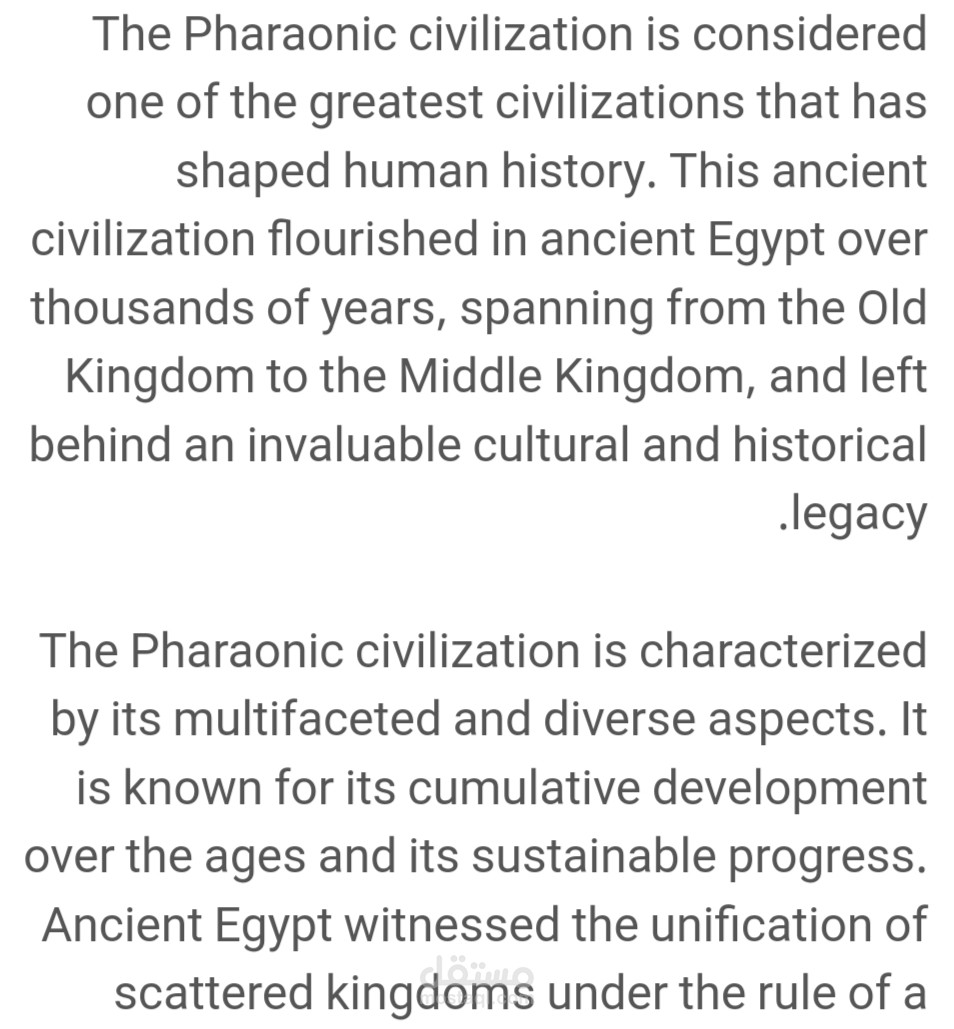الحضاره الفرعونيه
تفاصيل العمل
The Pharaonic civilization is considered one of the greatest civilizations that has shaped human history. This ancient civilization flourished in ancient Egypt over thousands of years, spanning from the Old Kingdom to the Middle Kingdom, and left behind an invaluable cultural and historical legacy.
The Pharaonic civilization is characterized by its multifaceted and diverse aspects. It is known for its cumulative development over the ages and its sustainable progress. Ancient Egypt witnessed the unification of scattered kingdoms under the rule of a single pharaoh, establishing a powerful centralized society characterized by precise and hierarchical organization.
One important aspect of the Pharaonic civilization is the development of architecture and engineering. The ancient Egyptians built the famous pyramids, which are considered one of the Seven Wonders of the Ancient World. These pyramid structures served as tombs for the pharaohs, who believed in an afterlife. They also constructed magnificent temples and palaces, distinguished by their intricate details and colossal statues that reflect Pharaonic sculptural art.
The Pharaonic civilization is also characterized by its polytheistic religion. The ancient Egyptians worshipped various gods and goddesses, each with their own role in daily and afterlife affairs. The stories of Egyptian gods and myths extend to later eras, influencing culture and literature.
Translation:
The Pharaonic civilization is one of the greatest civilizations that left an imprint on human history. This ancient civilization thrived in ancient Egypt over thousands of years, between the Old and Middle Kingdoms, leaving behind an invaluable cultural and historical legacy.
The Pharaonic civilization is characterized by its multiple and diverse aspects, as it is distinguished by its cumulative and sustainable development over the ages. Ancient Egypt witnessed the unification of scattered kingdoms under the rule of a single pharaoh, establishing a strong centralized society with precise and hierarchical organization.
One important aspect of the Pharaonic civilization is the development of architecture and engineering. The ancient Egyptians built the famous pyramids, which are considered one of the Seven Wonders of the Ancient World. These pyramid structures served as tombs for the pharaohs who believed in the afterlife. They also built their magnificent temples and palaces, characterized by intricate details and colossal statues that reflect Pharaonic sculptural art.
The Pharaonic civilization is also known for its polytheistic religion. The ancient Egyptians worshipped various gods and goddesses, each with their own role in daily and afterlife affairs. The stories of Egyptian gods and myths extend to later eras, influencing culture and literature.
الحضارة الفرعونية: إشراقة العجائب والروعة
تعتبر الحضارة الفرعونية واحدة من أعظم الحضارات التي طبعت تاريخ البشرية. ازدهرت هذه الحضارة العريقة في مصر القديمة على مدار آلاف السنين، بين العصور القديمة والوسطى، وتركت وراءها إرثاً ثقافياً وتاريخياً لا يقدر بثمن.
تتسم الحضارة الفرعونية بتعدد جوانبها وتنوعها، فهي تمتاز بتطورها المتراكم على مر العصور وتطورها المستدام. شهدت مصر القديمة توحيد الممالك المتناثرة تحت سيطرة فرعون واحد، وأسست مجتمعًا مركزيًا قويًا يتمتع بتنظيم دقيق وهرمي.
أحد الجوانب المهمة في الحضارة الفرعونية هو تطور العمارة والهندسة. قام المصريون القدماء ببناء الأهرامات الشهيرة التي تعد من أعجوبة العالم السبع القديمة. كانت تلك الهياكل الهرمية ضريحًا للفراعنة الذين كانوا يؤمنون بالحياة بعد الموت. كما بنوا معابدهم وقصورهم الفخمة، وقد تميزت تلك البنايات بتفاصيلها الدقيقة وتماثيلها الضخمة التي تعكس فن النحت الفرعوني.
تمتاز الحضارة الفرعونية أيضًا بديانتها المتعددة. كان المصريون القدماء يؤمنون بعبادة الآلهة والإلهات المختلفة، وكان لكل إله دوره الخاص في الحياة اليومية والأخروية. تمتد قصص الآلهة والأساطير المصرية إلى عصور لاحقة، حيث أثرت على الثقافة والأدب.
بطاقة العمل
| اسم المستقل | عبدالرحمن ث. |
| عدد الإعجابات | 0 |
| عدد المشاهدات | 14 |
| تاريخ الإضافة | |
| تاريخ الإنجاز |

